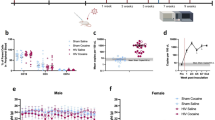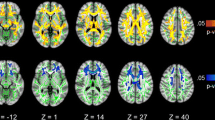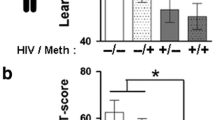Abstract
Studies of the effects of drugs of abuse on HIV immune status, disease progression, and neuroAIDS have produced conflicting data and have not definitively shown whether this combination promotes cognitive impairment or disease progression. Using a consistent SIV–macaque model, we investigated the effects of cocaine on behavior, virologic parameters, and CNS inflammation. Macaques received either vehicle or chronic administration of behaviorally active doses of cocaine (1.7 or 3.2 mg/kg/day). Chronic cocaine administration reduced CD8+ T cell counts during acute and late stage infection but had no effect on CD4+ T cell counts. Low-dose cocaine-treated animals had lower CSF vRNA levels late in infection, but cocaine did not alter plasma viral load or vRNA or protein in brain. There were no differences in CSF CCL-2 or interleukin (IL)-6 levels or severity of encephalitis in cocaine-treated as compared to vehicle-treated macaques. There were no differences in brain inflammation or neurodegeneration markers, as determined by interferon (IFN)-β, MxA, CCL2, IL-6, TNFα, IFNγ, and indolamine 2,3-deoxygenase mRNA levels. APP levels also were not altered. The executive function of inhibitory control was not impaired in cocaine-treated or control animals following SIV infection. However, animals receiving 3.2 mg/kg/day cocaine performed more slowly in a bimanual motor test. Thus, chronic administration of cocaine produced only minor changes in behavior, encephalitis severity, CNS inflammation/neurodegeneration, and virus replication in SIV-infected pigtailed macaques, suggesting that cocaine would have only modest effects on the progression of neuroAIDS in HIV-infected individuals.







Similar content being viewed by others
References
Baldwin GC, Roth MD, Tashkin DP (1998) Acute and chronic effects of cocaine on the immune system and the possible link to AIDS. J Neuroimmunol 83:133–138
Baum MK, Rafie C, Lai S, Sales S, Page B, Campa A (2009) Crack-cocaine use accelerates HIV disease progression in a cohort of HIV-positive drug users. J Acquir Immune Defic Syndr 50:93–99
Black YD, Green-Jordan K, Eichenbaum HB, Kantak KM (2004) Hippocampal memory system function and the regulation of cocaine self-administration behavior in rats. Behav Brain Res 151:225–238
Brewer TH, Zhao W, Pereyra M, Del Rio C, Loughlin A, Anderson-Mahoney P, Gardner L, Metsch LR (2007) Initiating HIV care: attitudes and perceptions of HIV positive crack cocaine users. AIDS Behav 11(6):897–904
Centers for Disease Control and Prevention (2002) Fact sheet: drug-associated HIV transmission continues in the United States. Department of Health and Human Services, Centers for Disease Control and Prevention, Atlanta
Chaisson RE, Bacchetti P, Osmond D, Brodie B, Sande MA, Moss AR (1989) Cocaine use and HIV infection in intravenous drug users in San Francisco. JAMA 261:561–565
Chander G, Himelhoch S, Moore RD (2006) Substance abuse and psychiatric disorders in HIV-positive patients: epidemiology and impact on antiretroviral therapy. Drugs 66:769–789
Chelonis JJ, Gillam MP, Paule MG (2003) The effects of prenatal cocaine exposure on reversal learning using a simple visual discrimination task in rhesus monkeys. Neurotoxicol Teratol 25:437–446
Concha M, Graham NM, Munoz A, Vlahov D, Royal W 3rd, Updike M, Nance-Sproson T, Selnes OA, McArthur JC (1992) Effect of chronic substance abuse on the neuropsychological performance of intravenous drug users with a high prevalence of HIV-1 seropositivity. Am J Epidemiol 136:1338–1348
Concha M, Selnes OA, Vlahov D, Nance-Sproson T, Updike M, Royal W, Palenicek J, McArthur JC (1997) Comparison of neuropsychological performance between AIDS-free injecting drug users and homosexual men. Neuroepidemiology 16:78–85
Cook JA, Burke-Miller JK, Cohen MH, Cook RL, Vlahov D, Wilson TE, Golub ET, Schwartz RM, Howard AA, Ponath C, Plankey MW, Levine AM, Grey DD (2008) Crack cocaine, disease progression, and mortality in a multicenter cohort of HIV-1 positive women. AIDS 22:1355–1363
Di Franco MJ, Sheppard HW, Hunter DJ, Tosteson TD, Ascher MS (1996) The lack of association of marijuana and other recreational drugs with progression to AIDS in the San Francisco Men’s Health Study. Ann Epidemiol 6:283–289
Drucker E (1986) AIDS and addiction in New York City. Am J Drug Alcohol Abuse 12:165–181
Evans EB, Wenger GR (1992) Effects of drugs of abuse on acquisition of behavioral chains in squirrel monkeys. Psychopharmacology (Berl) 107:55–60
Farfel GM, Kleven MS, Woolverton WL, Seiden LS, Perry BD (1992) Effects of repeated injections of cocaine on catecholamine receptor binding sites, dopamine transporter binding sites and behavior in rhesus monkey. Brain Res 578:235–243
Fiala M, Gan XH, Zhang L, House SD, Newton T, Graves MC, Shapshak P, Stins M, Kim KS, Witte M, Chang SL (1998) Cocaine enhances monocyte migration across the blood-brain barrier. Cocaine’s connection to AIDS dementia and vasculitis? Adv Exp Med Biol 437:199–205
Gendle MH, White TL, Strawderman M, Mactutus CF, Booze RM, Levitsky DA, Strupp BJ (2004) Enduring effects of prenatal cocaine exposure on selective attention and reactivity to errors: evidence from an animal model. Behav Neurosci 118:290–297
Griffin WC 3rd, Middaugh LD, Tyor WR (2007) Chronic cocaine exposure in the SCID mouse model of HIV encephalitis. Brain Res 1134:214–219
Harvey JA (2004) Cocaine effects on the developing brain: current status. Neurosci Biobehav Rev 27:751–764
Heyser CJ, Chen WJ, Miller J, Spear NE, Spear LP (1990) Prenatal cocaine exposure induces deficits in Pavlovian conditioning and sensory preconditioning among infant rat pups. Behav Neurosci 104:955–963
Horn TF, Huitron-Resendiz S, Weed MR, Henriksen SJ, Fox HS (1998) Early physiological abnormalities after simian immunodeficiency virus infection. Proc Natl Acad Sci U S A 95:15072–15077
Hughes A, Sathe N, Spagnola K (2008) State estimates of substance use from the 2005–2006 national surveys on drug abuse and health. Dept. of Health and Human Services, Substance Abuse and Mental Health Services Administration, Office of Applied Studies, Rockville
Jovanovski D, Erb S, Zakzanis KK (2005) Neurocognitive deficits in cocaine users: a quantitative review of the evidence. J Clin Exp Neuropsychol 27:189–204
Kantak KM, Udo T, Ugalde F, Luzzo C, Di Pietro N, Eichenbaum HB (2005) Influence of cocaine self-administration on learning related to prefrontal cortex or hippocampus functioning in rats. Psychopharmacology (Berl) 181:227–236
Kleven MS, Woolverton WL (1996) Effects of exposure regimen on changes in sensitivity to the effects of cocaine on schedule-controlled behavior in rhesus monkeys. Behav Brain Res 79:101–107
Korthuis PT, Zephyrin LC, Fleishman JA, Saha S, Josephs JS, McGrath MM, Hellinger J, Gebo KA (2008) Health-related quality of life in HIV-infected patients: the role of substance use. AIDS Patient Care STDs 22:859–867
Kumar AM, Borodowsky I, Fernandez B, Gonzalez L, Kumar M (2007) Human immunodeficiency virus type 1 RNA levels in different regions of human brain: quantification using real-time reverse transcriptase-polymerase chain reaction. J Neurovirol 13:210–224
Langford D, Marquie-Beck J, de Almeida S, Lazzaretto D, Letendre S, Grant I, McCutchan JA, Masliah E, Ellis RJ (2006) Relationship of antiretroviral treatment to postmortem brain tissue viral load in human immunodeficiency virus-infected patients. J Neurovirol 12:100–107
Lundqvist T (2005) Cognitive consequences of cannabis use: comparison with abuse of stimulants and heroin with regard to attention, memory and executive functions. Pharmacol Biochem Behav 81:319–330
Mankowski JL, Clements JE, Zink MC (2002a) Searching for clues: tracking the pathogenesis of human immunodeficiency virus central nervous system disease by use of an accelerated, consistent simian immunodeficiency virus macaque model. J Infect Dis 186(Suppl 2):S199–S208
Mankowski JL, Queen SE, Tarwater PM, Fox KJ, Perry VH (2002b) Accumulation of beta-amyloid precursor protein in axons correlates with CNS expression of SIV gp41. J Neuropathol Exp Neurol 61:85–90
Mankowski JL, Queen SE, Clements JE, Zink MC (2004) Cerebrospinal fluid markers that predict SIV CNS disease. J Neuroimmunol 157:66–70
Neblett RC, Davey-Rothwell M, Chander G, Latkin CA (2011) Social network characteristics and HIV sexual risk behavior among urban African American Women. J Urban Health 88:54–65
Paule MG (2005) Chronic drug exposures during development in nonhuman primates: models of brain dysfunction in humans. Front Biosci 10:2240–2249
Paule MG, Gillam MP, Morris P (1998) The effects of cocaine on nonhuman primate brain function are age dependent. Ann N Y Acad Sci 844:178–182
Peretti-Watel P, Spire B, Lert F, Obadia Y (2006) Drug use patterns and adherence to treatment among HIV-positive patients: evidence from a large sample of French outpatients (ANRS-EN12-VESPA 2003). Drug Alcohol Depend 82(Suppl 1):S71–S79
Rodriguez-Arenas MA, Jarrin I, del Amo J, Iribarren JA, Moreno S, Viciana P, Pena A, Sirvent JL, Vidal F, Lacruz J, Gutierrez F, Oteo JA, Asencio R, Castilla J, Hoyos SP (2006) Delay in the initiation of HAART, poorer virological response, and higher mortality among HIV-infected injecting drug users in Spain. AIDS Res Hum Retroviruses 22:715–723
Rogers RD, Robbins TW (2001) Investigating the neurocognitive deficits associated with chronic drug misuse. Curr Opin Neurobiol 11:250–257
Selnes OA, McArthur JC, Royal W 3rd, Updike ML, Nance-Sproson T, Concha M, Gordon B, Solomon L, Vlahov D (1992) HIV-1 infection and intravenous drug use: longitudinal neuropsychological evaluation of asymptomatic subjects. Neurology 42:1924–1930
Selnes OA, Galai N, McArthur JC, Cohn S, Royal W 3rd, Esposito D, Vlahov D (1997) HIV infection and cognition in intravenous drug users: long-term follow-up. Neurology 48:223–230
Siddiqui NS, Brown LS Jr, Makuch RW (1993) Short-term declines in CD4 levels associated with cocaine use in HIV-1 seropositive, minority injecting drug users. J Natl Med Assoc 85:293–296
Spear LP, Campbell J, Snyder K, Silveri M, Katovic N (1998) Animal behavior models. Increased sensitivity to stressors and other environmental experiences after prenatal cocaine exposure. Ann N Y Acad Sci 846:76–88
Tobias CR, Cunningham W, Cabral HD, Cunningham CO, Eldred L, Naar-King S, Bradford J, Sohler NL, Wong MD, Drainoni ML (2007) Living with HIV but without medical care: barriers to engagement. AIDS Patient Care STDs 21:426–434
Tozzi V, Balestra P, Galgani S, Narciso P, Sampaolesi A, Antinori A, Giulianelli M, Serraino D, Ippolito G (2001) Changes in neurocognitive performance in a cohort of patients treated with HAART for 3 years. J Acquir Immune Defic Syndr 28:19–27
Tyor WR, Middaugh LD (1999) Do alcohol and cocaine abuse alter the course of HIV-associated dementia complex? J Leukoc Biol 65:475–481
Udo T, Ugalde F, DiPietro N, Eichenbaum HB, Kantak KM (2004) Effects of persistent cocaine self-administration on amygdala-dependent and dorsal striatum-dependent learning in rats. Psychopharmacology (Berl) 174:237–245
Weed MR, Steward DJ (2005) Neuropsychopathology in the SIV/macaque model of AIDS. Front Biosci 10:710–727
Weed MR, Hienz RD (2006) Effects of morphine on circadian rhythms of motor activity and body temperature in pig-tailed macaques. Pharmacol Biochem Behav 84:487–496
Weed MR, Hienz RD, Brady JV, Adams RJ, Mankowski JL, Clements JE, Zink MC (2003) Central nervous system correlates of behavioral deficits following simian immunodeficiency virus infection. J Neurovirol 9:452–464
Weed MR, Gold LH, Polis I, Koob GF, Fox HS, Taffe MA (2004) Impaired performance on a rhesus monkey neuropsychological testing battery following simian immunodeficiency virus infection. AIDS Res Hum Retroviruses 20:77–90
Winsauer PJ, Silvester KR, Moerschbaecher JM, France CP (2000) Cocaine self-administration in monkeys: effects on the acquisition and performance of response sequences. Drug Alcohol Depend 59:51–61
Woolverton WL, Kleven MS (1988) Evidence for cocaine dependence in monkeys following a prolonged period of exposure. Psychopharmacology (Berl) 94:288–291
Xu W, Flick T, Mitchell J, Knowles C, Ault K (1998) Interactive effects of cocaine and gender on thymocytes: a study of in vivo repeated cocaine exposure. Int J Immunopharmacol 20:737–749
Zink MC, Suryanarayana K, Mankowski JL, Shen A, Piatak M Jr, Spelman JP, Carter DL, Adams RJ, Lifson JD, Clements JE (1999) High viral load in the cerebrospinal fluid and brain correlates with severity of simian immunodeficiency virus encephalitis. J Virol 73:10480–10488
Zink MC, Coleman GD, Mankowski JL, Adams RJ, Tarwater PM, Fox K, Clements JE (2001) Increased macrophage chemoattractant protein-1 in cerebrospinal fluid precedes and predicts simian immunodeficiency virus encephalitis. J Infect Dis 184:1015–1021
Funding authors
MW and MCZ funded this study.
Disclaimers
The authors have no conflict of interests to disclose.
Sources of funding
This study was funded by NIH R01 DA12829, DA05831, and a gift from the Susan R. Scherer Educational Foundation.
Author information
Authors and Affiliations
Corresponding author
Rights and permissions
About this article
Cite this article
Weed, M., Adams, R.J., Hienz, R.D. et al. SIV/Macaque Model of HIV Infection in Cocaine Users: Minimal Effects of Cocaine on Behavior, Virus Replication, and CNS Inflammation. J Neuroimmune Pharmacol 7, 401–411 (2012). https://doi.org/10.1007/s11481-011-9281-8
Received:
Accepted:
Published:
Issue Date:
DOI: https://doi.org/10.1007/s11481-011-9281-8




